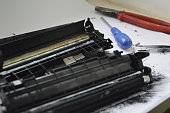The Vital Role of Pressure Rollers in Minimizing Print Waste
페이지 정보
작성자 Kayleigh 작성일 25-10-09 10:11 조회 4 댓글 0본문
Modern printers rely on pressure rollers to maintain optimal contact by maintaining steady contact between the ink delivery system and the media, whether that’s paper, plastic, fabric, or synthetic substrates. Consistent force is distributed over the entire contact area, ink transfers cleanly and خرابی غلطک پرس پرینتر sharply, eliminating smudges, streaks, and incomplete impressions. When rollers are misadjusted or worn, printers frequently generate defective output, leading to wasted resources, which squanders ink, toner, and paper.

Uneven ink transfer is a leading cause of rejected prints. If the pressure is too low, ink fails to transfer fully, creating unreadable or unacceptable output. Conversely, if the pressure is excessive, the image bleeds or smears, damaging the visual integrity. They provide the ideal solution to both under- and over-inking by maintaining optimal compression based on real-time conditions, thereby eliminating the need for trial prints, which directly reduces material usage.
Many advanced printing platforms now feature intelligent pressure control that detects media type and modifies compression dynamically. They rely on precision monitoring and adaptive algorithms to fine-tune roller pressure on the fly, eliminating variability between prints. This automation not only boosts productivity while reducing human error, which traditionally cause unnecessary reprints.
For print shops handling thousands of pages daily, even a 1% reduction in waste translates to substantial savings. Reducing the number of flawed pages, pressure rollers help conserve vital resources, they decrease environmental burden. Reduced reprinting lowers machine usage, reduces carbon footprint from printing operations.
Proper upkeep of rollers is critical for sustained performance. Surface wear and contamination gradually impair function, producing unpredictable output quality. Timely replacement prevents performance decline, preventing unexpected downtime. Forward-thinking print facilities now use usage-based predictive maintenance, further minimizing waste from aging equipment.
These components are foundational to sustainable printing. Through exacting control of contact force, they eliminate the need for corrections and reprints, thereby driving sustainable printing practices. Their impact echoes through cost, efficiency, and ecological outcomes.
- 이전글 Как услать пины со страницы в ВК? Ответы Mail
- 다음글 Inspiring Your Secondary 2 Student to Excel in Math: Strategies for Singapore Parents
댓글목록 0
등록된 댓글이 없습니다.
